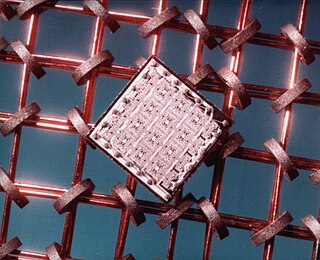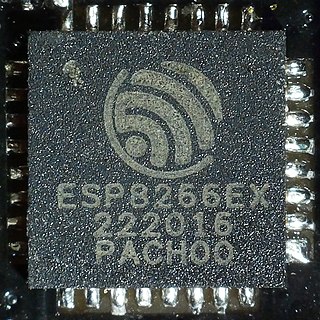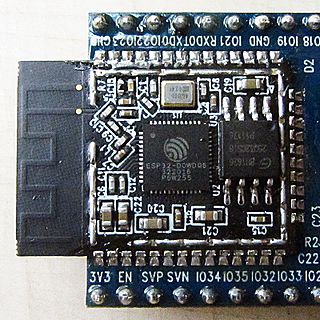Related Research Articles

A central processing unit (CPU)—also called a central processor or main processor—is the most important processor in a given computer. Its electronic circuitry executes instructions of a computer program, such as arithmetic, logic, controlling, and input/output (I/O) operations. This role contrasts with that of external components, such as main memory and I/O circuitry, and specialized coprocessors such as graphics processing units (GPUs).

Semiconductor device fabrication is the process used to manufacture semiconductor devices, typically integrated circuits (ICs) such as computer processors, microcontrollers, and memory chips that are present in everyday electrical and electronic devices. It is a multiple-step photolithographic and physio-chemical process during which electronic circuits are gradually created on a wafer, typically made of pure single-crystal semiconducting material. Silicon is almost always used, but various compound semiconductors are used for specialized applications.

Static random-access memory is a type of random-access memory (RAM) that uses latching circuitry (flip-flop) to store each bit. SRAM is volatile memory; data is lost when power is removed.

The history of computing hardware starting at 1960 is marked by the conversion from vacuum tube to solid-state devices such as transistors and then integrated circuit (IC) chips. Around 1953 to 1959, discrete transistors started being considered sufficiently reliable and economical that they made further vacuum tube computers uncompetitive. Metal–oxide–semiconductor (MOS) large-scale integration (LSI) technology subsequently led to the development of semiconductor memory in the mid-to-late 1960s and then the microprocessor in the early 1970s. This led to primary computer memory moving away from magnetic-core memory devices to solid-state static and dynamic semiconductor memory, which greatly reduced the cost, size, and power consumption of computers. These advances led to the miniaturized personal computer (PC) in the 1970s, starting with home computers and desktop computers, followed by laptops and then mobile computers over the next several decades.
In computer engineering, Halt and Catch Fire, known by the assembly mnemonic HCF, is an idiom referring to a computer machine code instruction that causes the computer's central processing unit (CPU) to cease meaningful operation, typically requiring a restart of the computer. It originally referred to a fictitious instruction in IBM System/360 computers, making a joke about its numerous non-obvious instruction mnemonics.
The 90 nm process is a level of MOSFET (CMOS) fabrication process technology that was commercialized by the 2003–2005 timeframe, by leading semiconductor companies like Toshiba, Sony, Samsung, IBM, Intel, Fujitsu, TSMC, Elpida, AMD, Infineon, Texas Instruments and Micron Technology.
The 65 nm process is an advanced lithographic node used in volume CMOS (MOSFET) semiconductor fabrication. Printed linewidths can reach as low as 25 nm on a nominally 65 nm process, while the pitch between two lines may be greater than 130 nm.

A multi-chip module (MCM) is generically an electronic assembly where multiple integrated circuits, semiconductor dies and/or other discrete components are integrated, usually onto a unifying substrate, so that in use it can be treated as if it were a larger IC. Other terms for MCM packaging include "heterogeneous integration" or "hybrid integrated circuit". The advantage of using MCM packaging is it allows a manufacturer to use multiple components for modularity and/or to improve yields over a conventional monolithic IC approach.
Free60 is the successor to the Xbox Linux Project that aims to put Linux, BSD, or Darwin on the Microsoft Xbox 360 using a software or hardware based "hack". The Xbox 360 uses hardware encryption and will not run unsigned code out of the box.

Microsoft XCPU, codenamed Xenon, is a CPU used in the Xbox 360 game console, to be used with ATI's Xenos graphics chip.
The transistor count is the number of transistors in an electronic device. It is the most common measure of integrated circuit complexity. The rate at which MOS transistor counts have increased generally follows Moore's law, which observes that transistor count doubles approximately every two years. However, being directly proportional to the area of a chip, transistor count does not represent how advanced the corresponding manufacturing technology is: a better indication of this is transistor density.
The 14 nm process refers to the MOSFET technology node that is the successor to the 22 nm node. The 14 nm was so named by the International Technology Roadmap for Semiconductors (ITRS). Until about 2011, the node following 22 nm was expected to be 16 nm. All 14 nm nodes use FinFET technology, a type of multi-gate MOSFET technology that is a non-planar evolution of planar silicon CMOS technology.
The Xbox 360 technical specifications describe the various components of the Xbox 360 video game console.

Read-only memory (ROM) is a type of non-volatile memory used in computers and other electronic devices. Data stored in ROM cannot be electronically modified after the manufacture of the memory device. Read-only memory is useful for storing software that is rarely changed during the life of the system, also known as firmware. Software applications for programmable devices can be distributed as plug-in cartridges containing ROM.

Random-access memory is a form of electronic computer memory that can be read and changed in any order, typically used to store working data and machine code. A random-access memory device allows data items to be read or written in almost the same amount of time irrespective of the physical location of data inside the memory, in contrast with other direct-access data storage media, where the time required to read and write data items varies significantly depending on their physical locations on the recording medium, due to mechanical limitations such as media rotation speeds and arm movement.
Per the International Technology Roadmap for Semiconductors, the 45 nm process is a MOSFET technology node referring to the average half-pitch of a memory cell manufactured at around the 2007–2008 time frame.
In semiconductor manufacturing, the International Technology Roadmap for Semiconductors defines the 7 nm process as the MOSFET technology node following the 10 nm node. It is based on FinFET technology, a type of multi-gate MOSFET technology.

The ESP8266 is a low-cost Wi-Fi microchip, with built-in TCP/IP networking software, and microcontroller capability, produced by Espressif Systems in Shanghai, China.

ESP32 is a series of low-cost, low-power system on a chip microcontrollers with integrated Wi-Fi and dual-mode Bluetooth. The ESP32 series employs either a Tensilica Xtensa LX6 microprocessor in both dual-core and single-core variations, Xtensa LX7 dual-core microprocessor or a single-core RISC-V microprocessor and includes built-in antenna switches, RF balun, power amplifier, low-noise receive amplifier, filters, and power-management modules. ESP32 is created and developed by Espressif Systems, a Chinese company based in Shanghai, and is manufactured by TSMC using their 40 nm process. It is a successor to the ESP8266 microcontroller.
References
- ↑ "IBM's eFuse technology portends adaptable chips".
- ↑ DCC (1989-03-14). "Method and apparatus for causing an open circuit in a conductive line". Archived from the original on 2017-02-11.
- 1 2 3 Smith, Tony. "IBM eFuse to yield self-repairing, self-regulating CPUs". The Register.
- 1 2 3 "Examining metal eFuses". EETAsia.
- ↑ "IBM introduces chip morphing technology". IBM. 2004-07-30. Archived from the original on 2010-07-24. Retrieved 2009-09-17.
- ↑ Port, Otis (2005-06-06). "Mighty Morphing Power Processors". BusinessWeek . Archived from the original on May 29, 2005.
- ↑ "Espressif ESP-IDF esp_mac.h". Espressif. 2023-06-08. Retrieved 2023-11-07.
- ↑ Amadeo, Ron (2022-08-31). "Google gives developers a way to sidestep Android 13's one-way update". Ars Technica. Retrieved 2022-09-04.
- ↑ Rizzolo, R. F.; Foote, T. G.; et al. (2007-02-13). "IBM System z9 eFUSE applications and methodology". IBM Journal of Research and Development. 51: 65–75. doi:10.1147/rd.511.0065 . Retrieved 2007-02-28.
- ↑ "Understanding the Xbox 360's Fusesets". Free60 Wiki.
- ↑ Speedy22 (2006-03-07). "XBOX 360 CPU Datasheet. Version 1.5" (PDF). Archived from the original (PDF) on 2006-03-15. Retrieved 2007-02-28.
{{cite web}}: CS1 maint: numeric names: authors list (link) - ↑ "IBM delivers Power-based chip for Microsoft Xbox 360 worldwide launch". IBM. 2005-10-25. Archived from the original on 2007-03-11. Retrieved 2007-02-28.
- ↑ "What is a Knox Warranty Bit and how is it triggered?". docs.samsungknox.com.
- ↑ "E-fuses". STMicroelectronics.